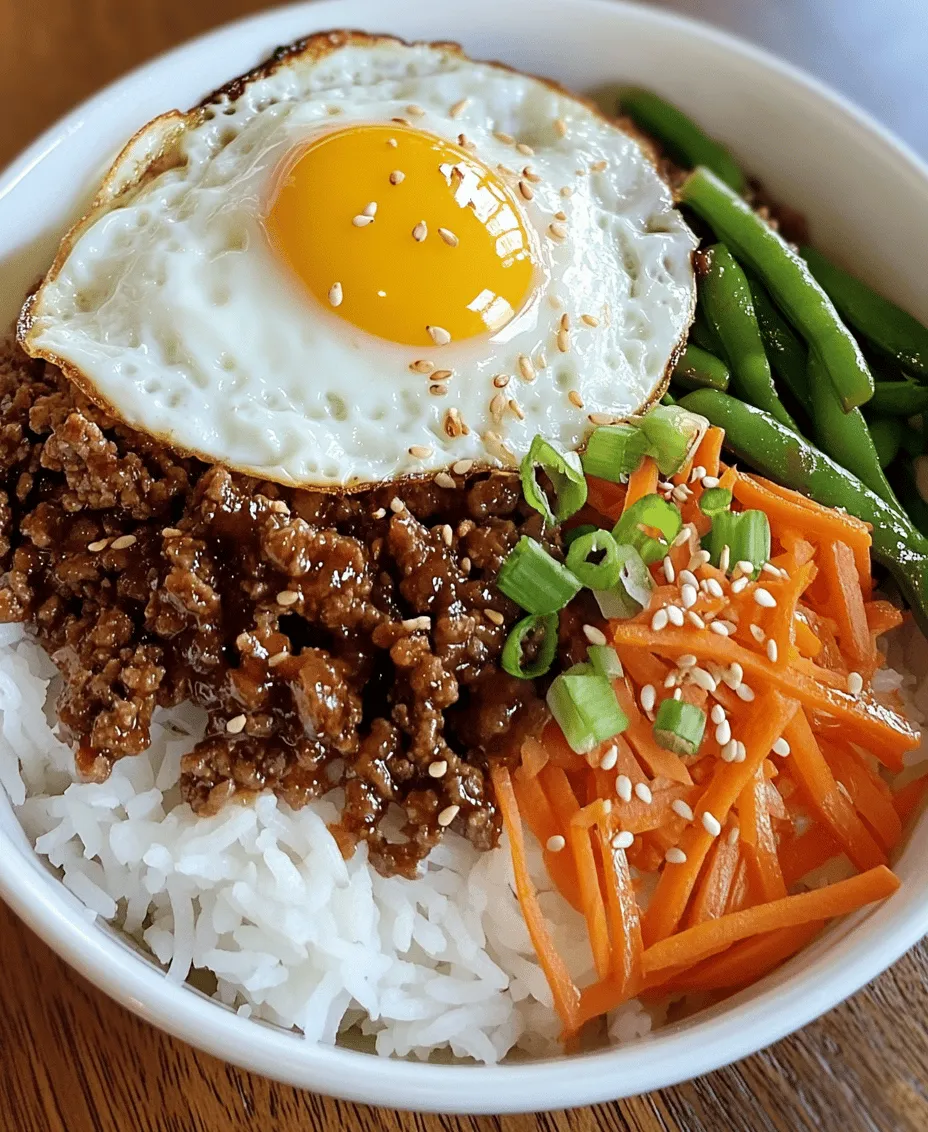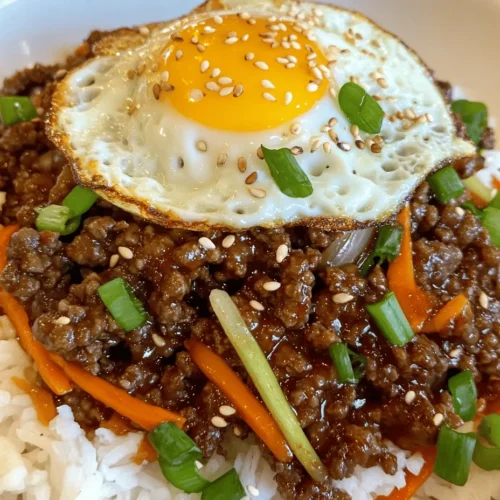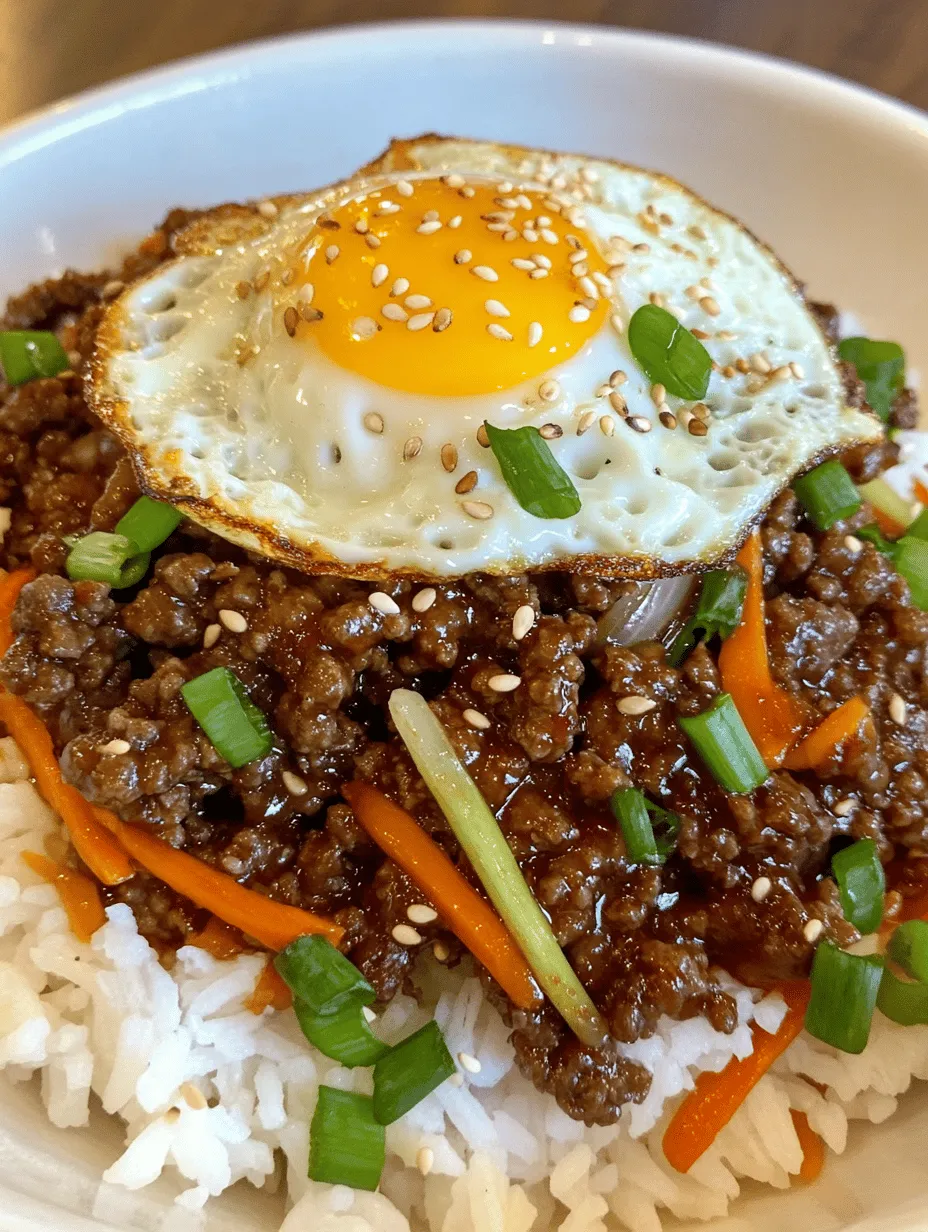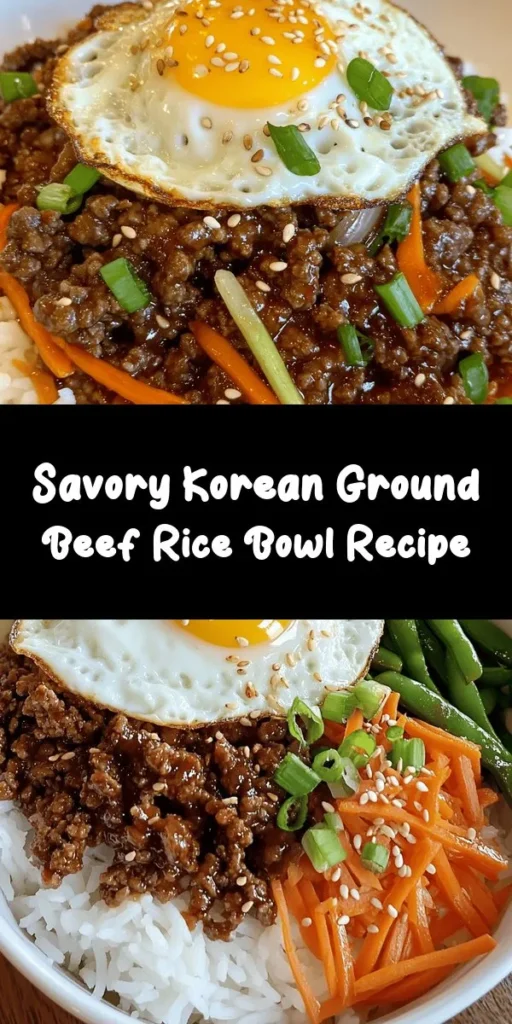Introduction
Korean cuisine has gained immense popularity in recent years, captivating food enthusiasts across the globe with its unique flavors, vibrant colors, and rich history. Known for its bold ingredients and intricate techniques, Korean dishes offer a delightful fusion of sweet, savory, and spicy flavors that tantalize the taste buds. Among the many offerings of this culinary tradition, the Korean Ground Beef Bowl stands out as a delicious, hearty, and satisfying meal that is both easy to prepare and immensely rewarding.
The Korean Ground Beef Bowl is a perfect representation of the balance found in Korean cooking. It combines the savory richness of ground beef with a medley of vegetables, all enhanced by a harmonious sauce that brings everything together. This dish is not only appealing to the eye but also to the palate, making it a go-to recipe for families and busy professionals alike. Its nutritious ingredients ensure that you are not just indulging in flavor, but also fueling your body with essential nutrients.
One of the key highlights of this recipe is its simplicity. With just a few staple ingredients and straightforward preparation steps, you can whip up a satisfying meal in no time. Whether you’re looking for a quick weeknight dinner or a dish to impress your guests, the Korean Ground Beef Bowl is a versatile option that checks all the boxes.
Understanding the Ingredients
To create an authentic and flavorful Korean Ground Beef Bowl, it’s essential to understand the key ingredients that make this dish shine. Each component plays a specific role, contributing to the overall flavor profile and nutritional value of the meal.
Ground Beef
Ground beef is the star of this dish, providing a rich source of protein that is essential for muscle growth and repair. When selecting ground beef, it’s important to choose a lean cut, ideally 80/20 or 90/10, to strike a balance between flavor and health. Leaner beef offers a healthier option while still delivering the delicious taste that ground beef is known for. Additionally, ground beef is versatile, allowing it to absorb the flavors of the accompanying sauce and ingredients beautifully.
Soy Sauce
Soy sauce is a staple in Korean cooking, known for its umami flavor that adds depth and richness to dishes. It serves as a primary seasoning in the Korean Ground Beef Bowl, enhancing the savory qualities of the beef while also contributing to the dish’s overall saltiness. When selecting soy sauce, opt for a quality, naturally brewed variety to ensure the best flavor. For those who prefer a gluten-free option, tamari is a suitable substitute that maintains similar tastes.
Gochujang
No Korean dish would be complete without gochujang, a fermented red chili paste that embodies the essence of Korean cuisine. This ingredient adds a unique spicy kick and a subtle sweetness that balances the flavors of the dish. Gochujang is made from red chili powder, glutinous rice, fermented soybeans, and salt, resulting in a thick, rich paste that enhances the savory notes of the beef and the sweetness of the brown sugar. It’s a must-have in any Korean pantry and can be adjusted to suit your spice tolerance.
Brown Sugar
Brown sugar plays a crucial role in balancing the flavors in the Korean Ground Beef Bowl. Its subtle sweetness counteracts the saltiness of the soy sauce and the heat from the gochujang, creating a well-rounded flavor profile. Additionally, brown sugar adds a hint of caramelization when cooked, enhancing the overall depth of flavor in the dish. If you prefer a healthier alternative, you can use coconut sugar or honey as substitutes, both of which offer a similar sweetness.
Sesame Oil
Sesame oil is another essential ingredient that contributes to the authenticity of this dish. Known for its nutty flavor and aroma, sesame oil is often used as a finishing oil in Korean cooking, imparting a rich taste that elevates the entire dish. It’s important to use toasted sesame oil for this recipe, as it provides a deeper flavor. Just a drizzle can transform the dish, making it more aromatic and appealing.
Garlic and Ginger
Garlic and ginger are fundamental aromatics in many Asian cuisines, including Korean. They not only contribute bold flavors but also offer numerous health benefits, such as anti-inflammatory properties and digestive support. Minced garlic adds a pungent, savory depth to the beef, while ginger introduces a warm, zesty note that complements the other ingredients beautifully. Together, they create a fragrant base that enhances the overall flavor of the dish.
Vegetables
The Korean Ground Beef Bowl typically features a variety of vegetables, with carrots and green beans being popular choices. These vegetables not only add color and texture but also boost the nutritional value of the dish. Carrots are rich in beta-carotene and fiber, while green beans provide vitamins A, C, and K, along with folate. You can also experiment with other vegetables like bell peppers, zucchini, or broccoli for added variety and nutrition. Just ensure that they are cut into uniform sizes for even cooking.
The Cooking Process: Step-by-Step Breakdown
Now that we’ve covered the essential ingredients, let’s dive into the cooking process. The preparation of the Korean Ground Beef Bowl is straightforward yet allows for creativity in balancing flavors and textures.
Preparing the Sauce
The heart of the Korean Ground Beef Bowl lies in its sauce, which requires careful balancing of flavors. Start by measuring out the soy sauce, gochujang, brown sugar, and sesame oil in a small bowl. Whisk them together until the sugar is fully dissolved. This mixture will serve as the seasoning for the beef and vegetables, infusing them with a deliciously savory and slightly sweet flavor.
As you prepare the sauce, consider the following tips for achieving the perfect balance:
– Taste as You Go: Once the sauce is mixed, taste it. If you prefer a spicier flavor, you can add more gochujang. For a sweeter profile, add a bit more brown sugar.
– Adjust Consistency: If the sauce is too thick, you can thin it out with a splash of water. Conversely, if you prefer a thicker sauce, simmer it for a few minutes to reduce it slightly.
Cooking the Beef
With the sauce ready, it’s time to cook the ground beef. In a large skillet or wok, heat a tablespoon of oil over medium-high heat. Once the oil is shimmering, add the ground beef to the pan. Use a wooden spoon or spatula to break up the meat into small pieces as it cooks.
Brown the beef thoroughly, ensuring that it develops a nice crust for added flavor. This typically takes about 5 to 7 minutes. Keep an eye on the heat; while you want a good browning, you don’t want the beef to burn.
Once the beef is browned, drain any excess fat from the pan. This step is important for both flavor and health, as it reduces the overall fat content of the dish. After draining, return the pan to the heat and pour the prepared sauce over the beef. Stir well to ensure that the meat is evenly coated and allow it to simmer for a few minutes, letting the flavors meld together.
Adding the Vegetables
As the beef simmers with the sauce, it’s time to add the vegetables. Start by adding the minced garlic and ginger to the pan. Sauté for about 30 seconds until fragrant, then add the sliced carrots and green beans. It’s essential to maintain the crunchiness of the vegetables while ensuring they are cooked through.
Stir the vegetables into the beef mixture, allowing them to absorb the sauce’s flavors. Cook for an additional 3 to 5 minutes, stirring occasionally, until the vegetables are tender yet still crisp. The aim is to achieve a perfect balance between the cooked beef and the vibrant, crunchy vegetables.
This step is crucial for texture. Undercooked vegetables provide a satisfying crunch that contrasts beautifully with the tender beef, enhancing the overall eating experience. As the dish nears completion, take a moment to taste the mixture. Adjust seasoning if necessary, adding more soy sauce or gochujang based on your preference.
As you can see, preparing the Korean Ground Beef Bowl is not just about following a recipe; it’s about understanding the ingredients, their roles, and how to achieve a harmonious dish that delights the senses. In the next part of our article, we will cover additional tips for serving, presentation, and variations to elevate your Korean Ground Beef Bowl experience even further.

Combining Everything
Once you have prepared your flavorful Korean ground beef mixture, the next step is to combine everything for a harmonious dish. Begin by adding the cooked beef back to the pan with any remaining sauce. Allow the mixture to simmer for about 5-10 minutes over medium-low heat. This crucial step is where the magic happens; simmering allows all the flavors to meld together, enhancing the overall taste of the dish. The result is a rich, savory mixture that is bursting with flavor.
As the beef simmers, taste the mixture and adjust the seasoning to your liking. If you prefer a sweeter profile, consider adding more brown sugar or a splash of honey. For those who enjoy a kick of heat, a dash of chili flakes or sriracha can elevate the dish. Remember, the beauty of this Korean ground beef bowl is its adaptability. Feel free to customize the seasoning to suit your palate, ensuring it’s a dish you’ll want to make over and over again.
Serving Suggestions
When it comes to serving your Korean ground beef bowl, there are numerous options to enhance the experience. Traditionally, this dish is served over a bed of rice, which acts as a perfect base to absorb the flavorful beef mixture.
Ideal Accompaniments for the Korean Ground Beef Bowl
The type of rice you use can greatly influence the dish. Jasmine rice, with its fragrant and slightly sticky texture, is an excellent choice that complements the flavors of the beef. Alternatively, sticky rice can provide a satisfying chewiness that pairs perfectly with the savory elements of the dish. For a healthier option, consider using brown rice or cauliflower rice for a lighter alternative.
Potential Side Dishes That Enhance the Meal
No Korean meal is complete without a variety of side dishes, known as banchan. Serving your Korean ground beef bowl with kimchi adds a tangy and spicy kick that beautifully contrasts the savory beef. Other excellent side dishes include pickled vegetables, which offer a refreshing crunch and balance the richness of the main dish. You might also consider serving a simple cucumber salad dressed with sesame oil for an added layer of texture and flavor.
Garnishing
Garnishing your bowl not only enhances the visual appeal but also adds extra flavor. While green onions and sesame seeds are traditional garnishes, there are many creative ideas to elevate your presentation. Fresh cilantro or basil can add a herbaceous note, while sliced radishes can introduce a pop of color and crunch.
Importance of Visual Appeal in Plating
When plating your Korean ground beef bowl, aim for a vibrant and inviting presentation. Start by placing a generous scoop of rice in the center of your bowl, then artfully layer the ground beef mixture on top, allowing some rice to peek through. Finish the dish with your chosen garnishes, and don’t shy away from adding a drizzle of your favorite sauce for an extra flair.
Exploring the Optional Fried Egg
In Korean cuisine, a fried egg is often added on top of rice dishes, including the Korean ground beef bowl, for a delightful twist. The inclusion of a fried egg not only enhances the meal’s richness but also offers a burst of creaminess when pierced.
Cultural Significance of Adding a Fried Egg
The fried egg is more than just a garnish; it represents a common practice in Korean cooking where eggs are utilized to elevate the texture and flavor of a dish. The yolk can serve as a sauce, creating a luscious blend with the beef and rice.
Variations on How to Cook the Egg for Different Textures
Depending on your preference, you can cook the egg in various ways. A sunny-side-up egg will allow the yolk to remain runny, creating a rich, saucy element when mixed into the bowl. If you prefer a firmer texture, an over-easy or over-hard egg will do the trick. For a unique twist, consider adding a sprinkle of gochugaru (Korean chili powder) on the egg for an added kick.
Nutritional Analysis of the Korean Ground Beef Bowl
Understanding the nutritional profile of your meal can enhance your dining experience. Here’s a breakdown of the calories, macronutrients, and vitamins you can expect per serving of the Korean ground beef bowl:
– Calories: Approximately 450-550 calories, depending on portion size and specific ingredients used.
– Macronutrients: Each serving typically contains around 25-30g of protein, 20-30g of carbohydrates, and 15-20g of fat. The balance of protein and carbohydrates makes this dish filling and satisfying.
– Vitamins: You’ll also benefit from essential vitamins like B vitamins from the beef and vitamin C from the vegetables.
Discussion on How to Make the Dish Healthier
To make this dish even healthier, consider using lean ground beef or substituting it with ground turkey or chicken. Adding more vegetables, such as bell peppers, spinach, or zucchini, can increase the fiber content while adding bulk and nutrients.
Addressing Dietary Restrictions and Modifications
For those with specific dietary needs, this recipe is easily adaptable. To create a gluten-free version, ensure that your soy sauce is gluten-free. A low-carb option can be achieved by serving the beef over cauliflower rice instead of traditional grains. For vegetarian alternatives, consider using textured vegetable protein or lentils as a meat substitute, allowing for a similar flavor profile while adhering to plant-based diets.
Cultural Insights
The Korean ground beef bowl is deeply rooted in the rich history of Korean cuisine. Bowls have been a staple in traditional Korean meals for centuries, serving as a versatile vessel for rice, vegetables, and proteins. This dish reflects the simple yet profound concept of Korean comfort food, where layered flavors and textures come together to create satisfying meals.
Exploring the History of Korean Bowls and Their Place in Traditional Korean Meals
In Korea, meals are typically served family-style, with various dishes laid out for everyone to share. The ground beef bowl embodies this communal spirit, allowing diners to customize their bowls with an array of ingredients and flavors. This dish signifies the harmony of flavors, a core principle in Korean cooking.
Discussing How the Korean Ground Beef Bowl Represents Modern Interpretations of Comfort Food
In modern times, Korean cuisine has seen a resurgence in popularity around the world. The Korean ground beef bowl represents a contemporary take on traditional flavors, making it accessible and appealing to a broader audience. Its quick preparation time and versatility make it an ideal choice for busy weeknights or casual gatherings.
The Global Influence of Korean Cuisine and Its Rise in Popularity
Korean food’s rise in popularity can be attributed to its bold flavors, health-conscious options, and the global fascination with K-pop culture. The Korean ground beef bowl, with its delicious taste and ease of preparation, is a testament to the growing interest in this vibrant cuisine.
Conclusion
The Korean ground beef bowl is a delightful and quick meal that embodies the essence of Korean cooking—flavorful, comforting, and satisfying. With its rich combination of seasoned beef, fragrant rice, and vibrant accompaniments, this dish invites you to explore the diverse flavors of Korean cuisine right in your kitchen.
Embracing the culinary traditions of different cultures enriches our cooking experience and encourages us to try new recipes. The Korean ground beef bowl is not just a meal; it’s an invitation to savor the deliciousness of Korean flavors and to experiment with your cooking skills. So why not gather your ingredients, follow the recipe, and embark on a delightful culinary journey that celebrates the essence of Korean cuisine? Enjoy the process and the delicious results!



